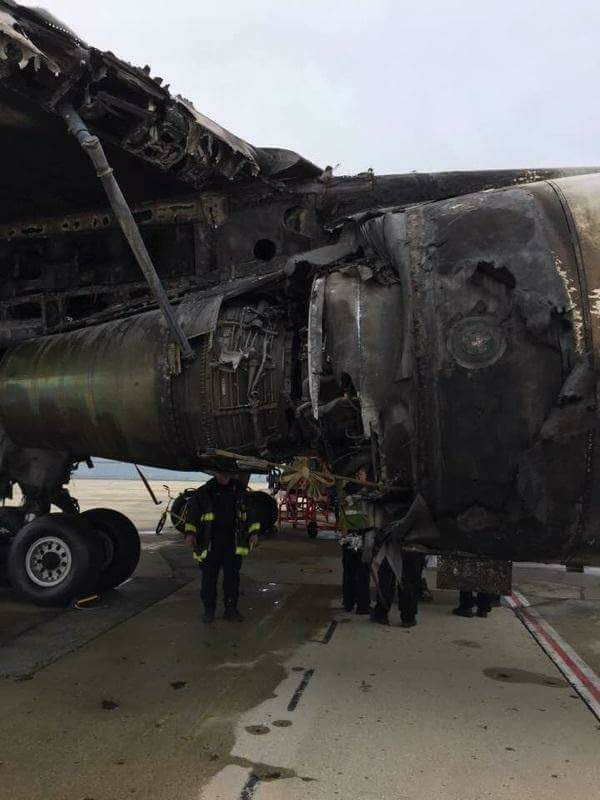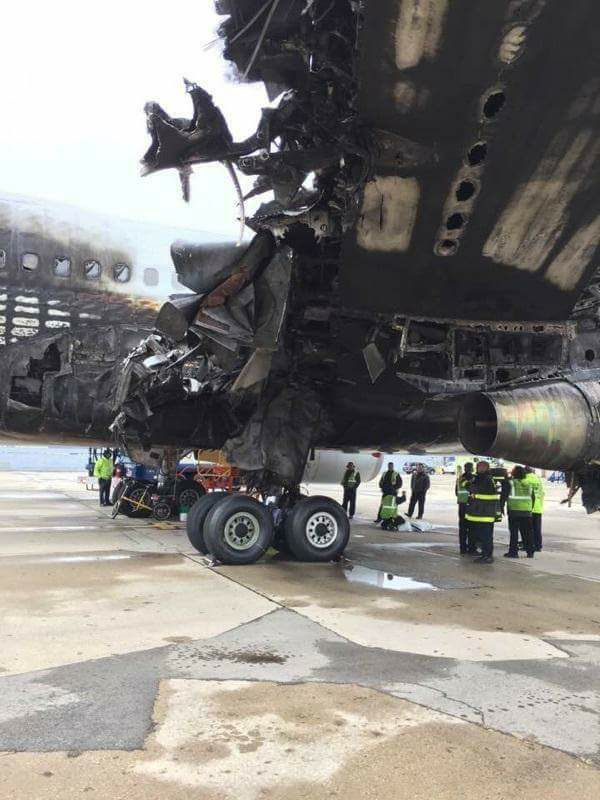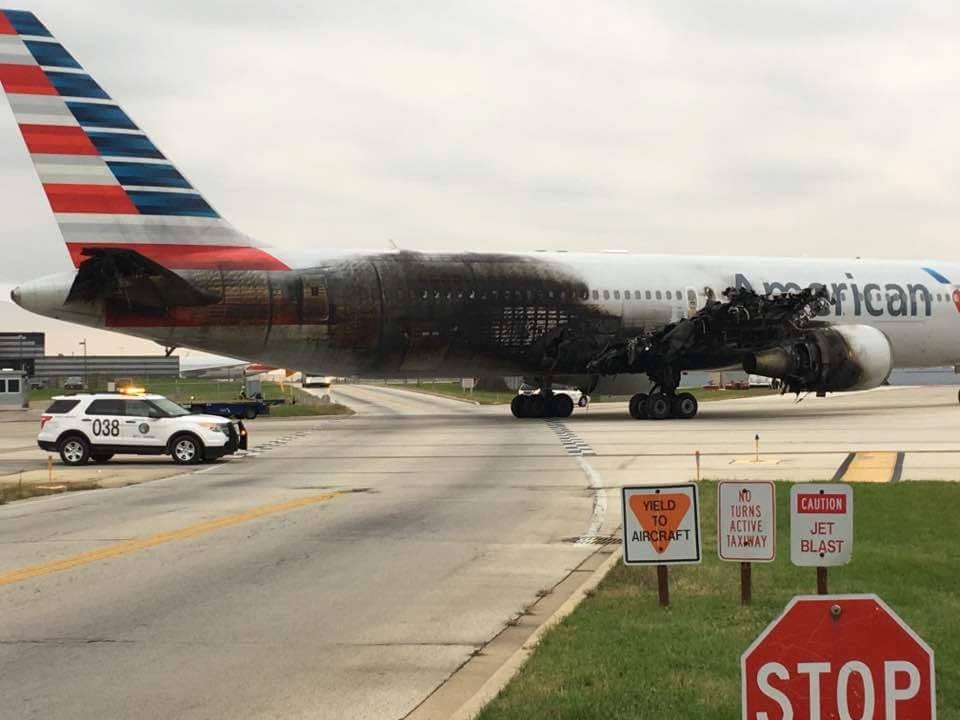It looks like you're using an Ad Blocker.
Please white-list or disable AboveTopSecret.com in your ad-blocking tool.
Thank you.
Some features of ATS will be disabled while you continue to use an ad-blocker.
share:
It appears that several right main tires blew, possibly from debris on the runway. The #2 HPT disk failed, resulting in an uncontained failure of the
engine. The damage to the cabin area was cosmetic, to windows, and cosmetic interior, and the fire never breached the cabin. Debris penetrated one
of the right hand fuel tanks, and the aircraft suffered the wing damage, as well as significant fuselage outer skin, and right hand horizontal
stabilizer damage.
originally posted by: Zaphod58
It appears that several right main tires blew, possibly from debris on the runway. The #2 HPT disk failed, resulting in an uncontained failure of the engine. The damage to the cabin area was cosmetic, to windows, and cosmetic interior, and the fire never breached the cabin. Debris penetrated one of the right hand fuel tanks, and the aircraft suffered the wing damage, as well as significant fuselage outer skin, and right hand horizontal stabilizer damage.
The reported sequence of events makes no sense. The main gear tires are way, way behind the engine inlet, too far back to have a chunk of blown tire ingested. I would propose a little different sequence. Under takeoff thrust there was a failure in the high pressure turbine section of the engine . The American Airlines before takeoff checklist requires the autobrake system to be set to RTO (rejected takeoff) mode.. T he autobrake system on the 767 can be manually set from 1 (low brake effort) to 4 (very high braking effectiveness) but RTO mode automatically sets braking to a level even higher than 4. The asymetric load caused by the failed engine combined with extreme braking caused the tire failure. Add the heat from the brakes trying to stop hundreds of tons of aircraft and you're asking a rubber tire to vastly exceed its capabilities. So what we have is an uncontained engine failure and a blown tire. But which came first? I vote turbine failure leading to blown tire. The DFDR will tell the tale.
originally posted by: Zaphod58
a reply to: F4guy
The sequence, according to a plane behind them was that they saw sparks at tire level before the fire started. The NTSB will have to determine which came first.
I'm sure they did see that. I'd think that both the engine failure and the tire failure occurred before the fire. It takes some time for the kerosene to vaporize enough to burn.
originally posted by: Zaphod58
a reply to: F4guy
You'd think, with pieces of the engine being thrown between a quarter and half mile, they would have seen bits of engine going flying though.
You would think so but if the uncontained pieces were turbine blade fragments, they are pretty small. High pressure section turbine blades are a lot smaller than the fan blades.
I'm guessing that the engine ingested something and started throwing turbine blades. The turbine blades are what took out the tires. The chances on
multiple tires failing at one time is slim to none.
They've recovered 90% of the engine. It will go for metallurgy tests then to GE for teardown.
Side question
Do they probably have a plane thats scrap? If so does it get removed from the airport how?? Trucks, train just cut up and scrapped some salvaged? I know a lot depends on a zillion things just curious if it is scrap it must be disassembled on site and hauled away.
General answer would be fine. Like save the other engine and cockpit, seats???
Or as bad as this looks would it be repaired possibly??
Thanks
Do they probably have a plane thats scrap? If so does it get removed from the airport how?? Trucks, train just cut up and scrapped some salvaged? I know a lot depends on a zillion things just curious if it is scrap it must be disassembled on site and hauled away.
General answer would be fine. Like save the other engine and cockpit, seats???
Or as bad as this looks would it be repaired possibly??
Thanks
a reply to: mikell
They'll scrap it in place. They'll salvage what can be, cut the fuselage up and scrap it. The salvaged parts will go into the supply chain. To repair it they'd have to replace the entire wing as well as the fuselage sections where it's damaged.
They'll scrap it in place. They'll salvage what can be, cut the fuselage up and scrap it. The salvaged parts will go into the supply chain. To repair it they'd have to replace the entire wing as well as the fuselage sections where it's damaged.
originally posted by: mikell
Till the final report being no fatalities the lawyers wouldn't be so rabid
Oh the lawyers will be rabid. "My client was so traumatized by this that he had to quit his job because he's afraid to fly again."
"My client was to traumatized that she can't have sexual relations with her husband." So on and so on.
This was the first ever failure of the second stage high pressure turbine in a CF6-80C2 engine. GE describes the engine as containing "very
high-cycle discs".




a reply to: roadgravel
They had to to tow it since both were on the rear truck. With mains like that, you can only tow it with one flat per truck.
They had to to tow it since both were on the rear truck. With mains like that, you can only tow it with one flat per truck.
new topics
-
God's Righteousness is Greater than Our Wrath
Religion, Faith, And Theology: 1 hours ago -
Electrical tricks for saving money
Education and Media: 4 hours ago -
VP's Secret Service agent brawls with other agents at Andrews
Mainstream News: 5 hours ago -
Sunak spinning the sickness figures
Other Current Events: 6 hours ago -
Nearly 70% Of Americans Want Talks To End War In Ukraine
Political Issues: 6 hours ago -
Late Night with the Devil - a really good unusual modern horror film.
Movies: 8 hours ago -
Cats Used as Live Bait to Train Ferocious Pitbulls in Illegal NYC Dogfighting
Social Issues and Civil Unrest: 9 hours ago -
The Good News According to Jesus - Episode 1
Religion, Faith, And Theology: 11 hours ago
top topics
-
Florida man's trip overseas ends in shock over $143,000 T-Mobile phone bill
Social Issues and Civil Unrest: 16 hours ago, 8 flags -
Cats Used as Live Bait to Train Ferocious Pitbulls in Illegal NYC Dogfighting
Social Issues and Civil Unrest: 9 hours ago, 8 flags -
VP's Secret Service agent brawls with other agents at Andrews
Mainstream News: 5 hours ago, 8 flags -
Bobiverse
Fantasy & Science Fiction: 16 hours ago, 3 flags -
HORRIBLE !! Russian Soldier Drinking Own Urine To Survive In Battle
World War Three: 13 hours ago, 3 flags -
Electrical tricks for saving money
Education and Media: 4 hours ago, 3 flags -
Nearly 70% Of Americans Want Talks To End War In Ukraine
Political Issues: 6 hours ago, 3 flags -
Sunak spinning the sickness figures
Other Current Events: 6 hours ago, 3 flags -
Late Night with the Devil - a really good unusual modern horror film.
Movies: 8 hours ago, 2 flags -
The Good News According to Jesus - Episode 1
Religion, Faith, And Theology: 11 hours ago, 1 flags
active topics
-
VP's Secret Service agent brawls with other agents at Andrews
Mainstream News • 38 • : SchrodingersRat -
New whistleblower Jason Sands speaks on Twitter Spaces last night.
Aliens and UFOs • 54 • : Ophiuchus1 -
DONALD J. TRUMP - 2024 Candidate for President - His Communications to Americans and the World.
2024 Elections • 514 • : WeMustCare -
The Acronym Game .. Pt.3
General Chit Chat • 7744 • : bally001 -
Truth Social goes public, be careful not to lose your money
Mainstream News • 128 • : Astyanax -
Sunak spinning the sickness figures
Other Current Events • 5 • : glen200376 -
SETI chief says US has no evidence for alien technology. 'And we never have'
Aliens and UFOs • 44 • : MikeDeGrasseTyson -
HORRIBLE !! Russian Soldier Drinking Own Urine To Survive In Battle
World War Three • 31 • : budzprime69 -
How ageing is" immune deficiency"
Medical Issues & Conspiracies • 33 • : rickymouse -
The Reality of the Laser
Military Projects • 46 • : Zaphod58

